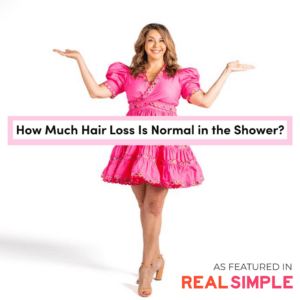Hair Loss in the Shower: How Much is Normal? | As Featured in Real Simple
Everyone loses hair, but it is always the most noticeable in the shower. Have you ever worried if you’re losing too much? Most people have the same concern and Dr. Mona Foad is here to answer your questions! Read more about hair loss in Real Simple’s full article.

Why do we lose hair and/or just notice it while we are in the shower?
It’s absolutely normal to notice more hair shedding in the shower. Washing and conditioning can help loosen up hairs that were already in the shedding phase. If you don’t wash or brush your hair daily, those hairs can build up and come out all at once. This makes it seem like you’re losing more than you actually are. The water and conditioner also cause the strands to clump together, so the shedding might look a little more dramatic than usual.
What causes this type of hair loss?
Shower shedding is usually just part of your hair’s natural cycle, but a few things can make it worse. Stress, diet, hormonal shifts, and even certain medical conditions can all play a role. If you’re dealing with something like stress or illness, you could be experiencing telogen effluvium. This is a temporary shedding phase that typically starts 3 to 4 months after being triggered by those factors. Other things like iron deficiency, thyroid issues, or even tight hairstyles can also make shedding more noticeable. If it persists or gets worse, it might be time to chat with a dermatologist to figure out what’s going on.
How much is “normal” to see in the shower?
A little shedding is normal! On average, we lose anywhere from 50 to 100 hairs a day. If you’re washing your hair, you might see a bit more than usual because the act of shampooing and conditioning loosens hairs that were ready to shed. It may feel like more if you don’t wash your hair every day, since those hairs accumulate. As long as it’s around that amount, it’s part of your natural hair cycle. But if you’re seeing large clumps or thinning spots, it might be worth investigating further.
How much hair loss in the shower is abnormal?
If you’re seeing large clumps of hair in the drain, noticing thinning patches, or feeling excessive shedding when you run your fingers through your hair, that could be a sign of something abnormal. Another good way to see if your hair is thinning is to put it in a ponytail and if the ponytail is thinner than normal, you might be suffering from some excess shedding. A sudden increase in shedding, visible scalp changes, or any itching or tenderness should definitely be looked at by a dermatologist to rule out any underlying issues.
What should you do if you notice that you’re losing more hair than normal in the shower?
First, don’t panic! If this is something new, and you’ve recently gone through stress, illness, or hormonal changes, it could just be temporary. Make sure you’re eating a healthy diet with enough protein, iron, and vitamins that support hair health. Consider switching to a gentle, sulfate-free shampoo and be mindful of heat styling or tight hairstyles. Collagen powders can also help but make sure you’re taking a marine short chain collagen If the shedding goes on for more than a couple of months, or you’re noticing thinning or scalp discomfort, it’s a good idea to see a dermatologist to dig into the cause and find the right treatment.
Is it possible to just see hair loss in the shower and not really notice it elsewhere? Why/why not?
It’s definitely possible to only notice hair loss in the shower. That’s because the washing process helps loosen hairs that were already in the shedding phase, so you might not see them as much throughout the day. But if thinning is happening, you might start seeing more hair on your pillow, in your brush, or around your home. If the shedding is only happening in the shower, it’s probably just normal, but if you start to notice changes in your overall hair density, it might be worth looking into more.
Final Thoughts?
Hair loss is a common concern, but the key is paying attention to sudden or significant changes. If you’re feeling worried, a dermatologist can assess your scalp, check for any underlying conditions, and recommend treatments. Options like topical minoxidil, PRP therapy, or lifestyle changes can help keep your hair healthy and growing.
